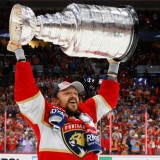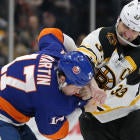If you've been watching the NHL over the past handful of years, you likely don't need numbers to tell you what's pretty obvious: The league and its product is not quite the same as it once was, say, in the 80s, 90s or even early 2000s.
Plenty about the game has changed, but one of the most noticeable differences comes in the lack of fighting relative to the days of "old time hockey." Goons and enforcers are becoming something of an endangered species in an NHL that has been steadily trending more towards speed and skill. As a result, fighting, while still "legal," is also trending downward.
Last season, the frequency of fighting hit historic lows once again. Here are some of the numbers curated in a piece from ESPN this week:
- There were 224 fights in which at least one player received a fighting major last season. That number drops from 280 such fights the prior season.
- There were 0.18 fights per game last season, marking the first time that the average has dropped below 0.20.
- Last season was the first time that the NHL had fewer than 200 games with a fighting major.
- Only 24 games last season featured more than one fight. The previous low was 41 games in 2017-18.
These numbers pale in comparison to some of the fighting statistics as recently as 10 years ago, and it's not all that hard to understand why. Not only have goons gone by the wayside as front offices place more emphasis on filling out rosters with skill on the back end, but there's also been more information gathered on CTE and the long-term effects of concussions and head trauma that can be suffered through fighting.
Several ex-NHL players have been vocal about the negative effects of fighting in recent years, especially after the struggles and early deaths of former enforcers such as Derek Boogaard and Bob Probert.
In the piece from ESPN's Greg Wyshynski, some of those former players, including some who frequently dropped the gloves during their playing days, discussed the cause and effect of decline in fighting. Dan Carcillo, who has been very outspoken regarding the long-term health issues caused by fighting and the league's failure to protect players, says "the game is better off without fighting, no doubt."
Though the NHL has been very reluctant to accept any blame or acknowledge a link between CTE in players and the violent nature of sport, a major concussion lawsuit involving more than 100 former NHL players reached a settlement with the league last November. As part of that agreement, the NHL will pay out between $17-$19 million while refusing any liability for the claims of those players.
As the knowledge and concern around head injuries continues to rise, it seems likely that the skill-focused NHL is here to stay while the furious face-punching days of hockey continue to be more and more a relic of the past.


















